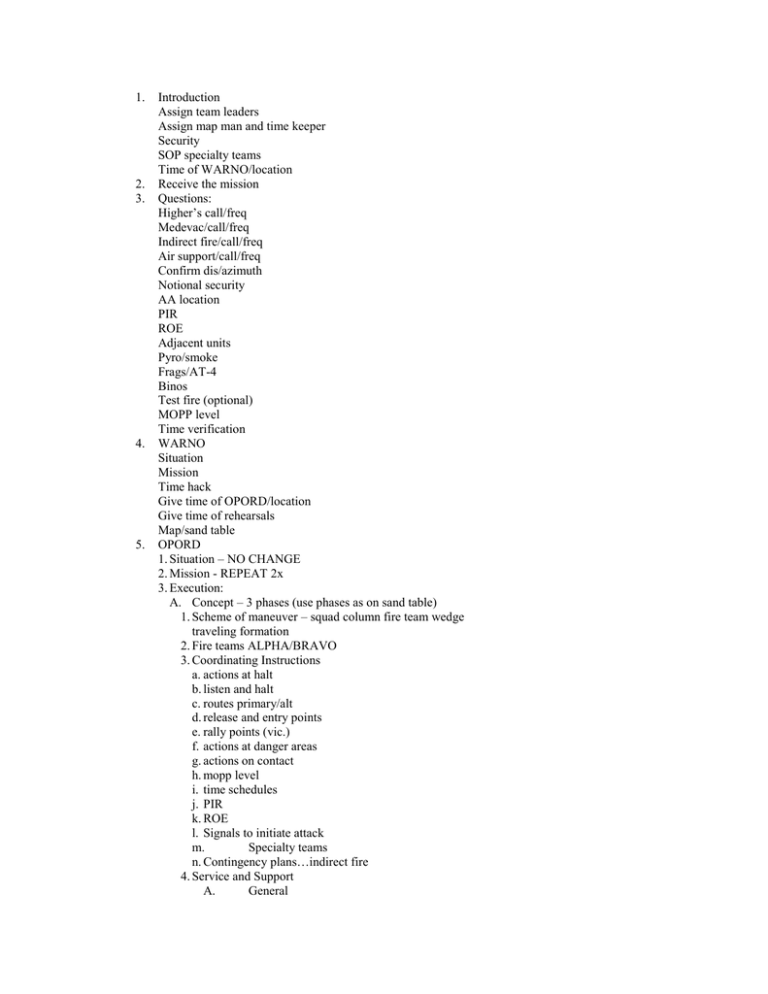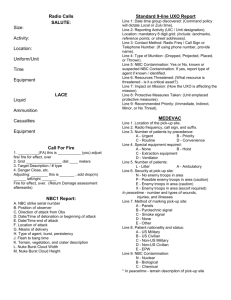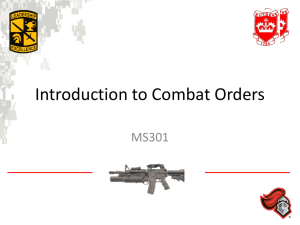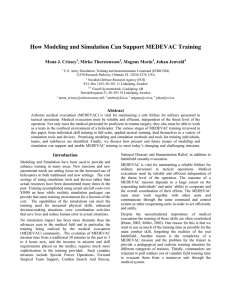1. Introduction Assign team leaders Assign map man and time keeper Security
advertisement

1. 2. 3. 4. 5. Introduction Assign team leaders Assign map man and time keeper Security SOP specialty teams Time of WARNO/location Receive the mission Questions: Higher’s call/freq Medevac/call/freq Indirect fire/call/freq Air support/call/freq Confirm dis/azimuth Notional security AA location PIR ROE Adjacent units Pyro/smoke Frags/AT-4 Binos Test fire (optional) MOPP level Time verification WARNO Situation Mission Time hack Give time of OPORD/location Give time of rehearsals Map/sand table OPORD 1. Situation – NO CHANGE 2. Mission - REPEAT 2x 3. Execution: A. Concept – 3 phases (use phases as on sand table) 1. Scheme of maneuver – squad column fire team wedge traveling formation 2. Fire teams ALPHA/BRAVO 3. Coordinating Instructions a. actions at halt b. listen and halt c. routes primary/alt d. release and entry points e. rally points (vic.) f. actions at danger areas g. actions on contact h. mopp level i. time schedules j. PIR k. ROE l. Signals to initiate attack m. Specialty teams n. Contingency plans…indirect fire 4. Service and Support A. General 5. 1. SOP’s in effect 2. Casualty collection points B. Material/Services 1. Supply – Re-up points 2. Transportation 3. Services 4. Maintenance – weapons, equipment C. Medevac – method, priority, location of CCP D. Personnel – method of handling EPW’s two man search method Command and Signal A. Command 1. Location of Higher CDR 2. Location of SL 3. Succession of command B. Signal 1. Listening and halt 2. Methods of COMMO 3. Emergency signals 4. Challenge and passwords 5. Running password 6. SOI in effect 7. Pyro-tech signals to initiate attack Questions… Back Brief…Time to LD….Rehearsals SALUTE Report Size Activity Location Unit/Uniform Time Equipment Mission Enemy Time Troops Terrain Observation Cover and Concealment Obstacles Key Terrain Avenues of Approach AA procedures 1. Quartering party recons AA and establishes security 2. Quartering party determines positions for platoon 3. Platoon moves outside perimeter, Quartering party guides in 4. Priorities of Work: 5. Crew served weapons range cards Fighting positions wire communication Cammo positions clear fields of fire Distribute ammo, water, rations, supplies, special equipment PCIs rehearsals Test fire personal hygiene Rest plan coordinate with adj. Units Establish Ops Squad leaders, PSG and PL fill out sector sketches 9-line MEDEVAC 1. Location of pick-up site 2. Radio freq, call sign at pick up site 3. Number of patients by precedence 4. Special equipment required 5. Number of Patients 6. Security at pick up point(war)# and type of wounded, injury, or illness (peace) 7. Method of marking pick up site 8. Patient nationality and status 9. NBC? (war) terrain description (peace) OPORD# Reference: Map Time Zone Task Organization Terrain: obstacles Effects on friendly Effects on enemy Avenues of approach Key terrain features Weather: precipitation Visibility Illumination Humidity Wind 1. 2. 3. Situation a. Enemy Forces 1. Disposition 2. Composition 3. Strength 4. Capabilities 5. Maneuver 6. Fire Support 7. Intel b. Friendly Forces 1. Higher units mission/Commander’s mission 2. Unit to left 3. Unit to right 4. Unit to front 5. Unit to rear 6. Unit in reserve Mission Execution Intent a. Concept of the operation 1. Maneuver 2. Fires a. Purpose to attack b. Priority c. Allocation d. Restrictions 3. Reconnaissance and surveillance 4. Intelligence 5. Engineering 6. Air Defense 7. PSYOPS b. Tasks to maneuver units 1. 1-PL/SQD – 4th/PL/SQD c. Tasks to combat support units d. Coordinating instructions 1. In the defense 2. In the offense e. f. 4. 5. a. b. c. d. Time matrix Grid matrix OEG MOPP PIR IR Service support a. General 1. loc of co trains 2. loc of BDE trains 3. Aid station 4. supply points/caches b. Material supply 1. supply (I-IX) 2. Transportation 3. Services 4. Maintenance c. Medical EVAC and hospitalization d. Personnel: 1. EPWs 2. Replacements e. Civil Military Co-ops f. Miscellaneous Command and Signal a. Command 1. co cp 2. BDE cp 3. Succession of command b. Signal 1. SOI



